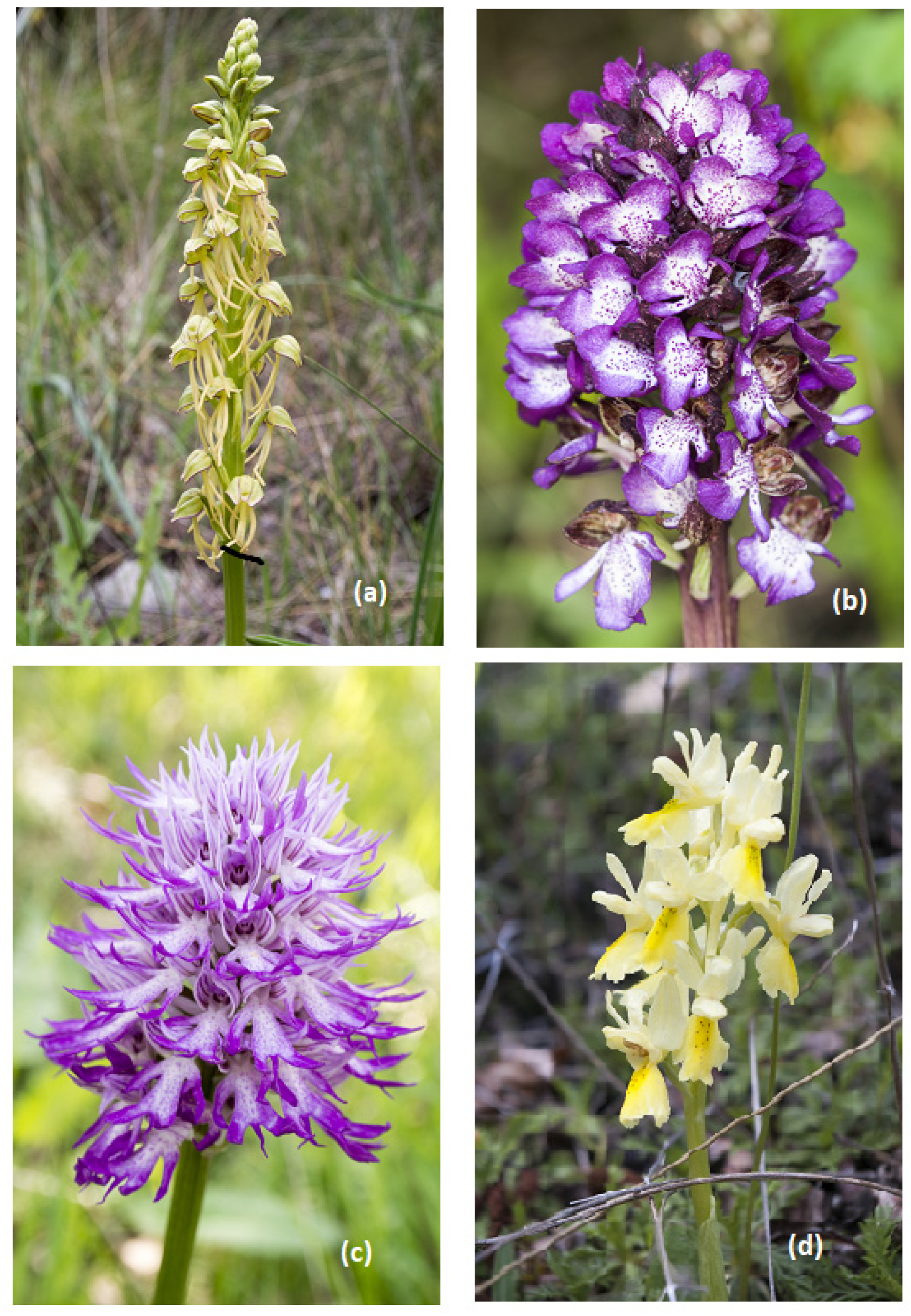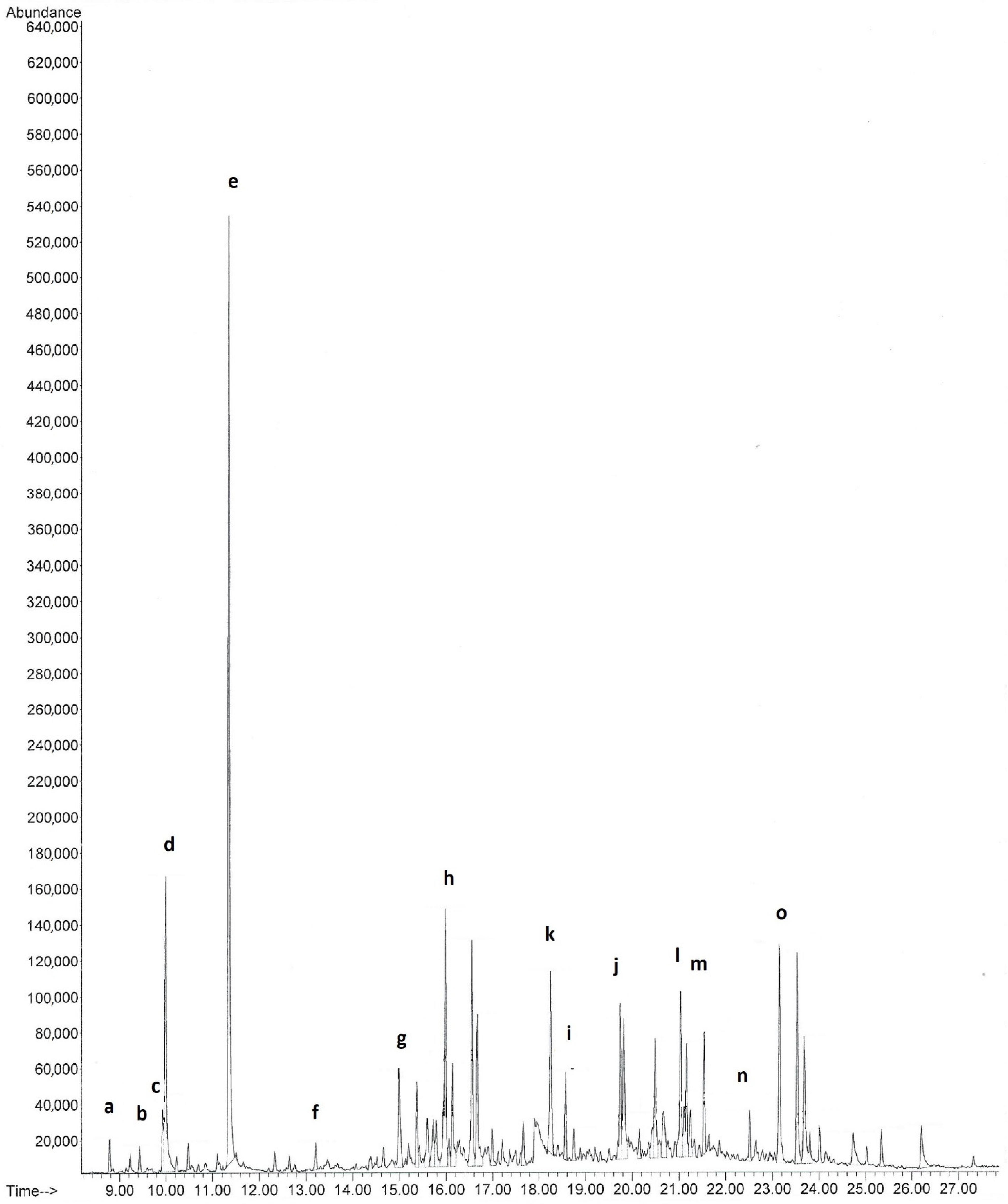Volatile Organic Compounds from Orchis Species Found in Basilicata (Southern Italy)
Abstract
:1. Introduction
2. Experimental Section
2.1. Plant Material
2.2. Analysis of Volatile Organic Compounds
3. Results
4. Discussion
5. Conclusions
Author Contributions
Funding
Data Availability Statement
Conflicts of Interest
References
- Ramya, M.; Jang, S.; An, H.-R.; Lee, S.-Y.; Park, P.-M.; Park, P.H. Volatile Organic Compounds from Orchids: From Synthesis and Function to Gene Regulation. Int. J. Mol. Sci. 2020, 21, 1160. [Google Scholar] [CrossRef] [Green Version]
- Apolonski, A.; Maiti, K.S. Towards a standard operating procedure for revealing hidden volatile organic compounds in breath: The Fourier-transform IR spectroscopy case. Appl. Opt. 2021, 60, 4217–4224. [Google Scholar] [CrossRef] [PubMed]
- Maiti, K.S.; Lewton, M.; Fill, E.; Apolonskiy, A. Sensitive spectroscopic breath analysis by water condensation. J. Breath Res. 2018, 12, 046003. [Google Scholar] [CrossRef] [PubMed]
- Maiti, K.S.; Lewton, M.; Fill, E.; Apolonski, A. Human beings as islands of stability: Monitoring body states using breath pro-files. Sci. Rep. 2019, 9, 16167. [Google Scholar] [CrossRef] [PubMed] [Green Version]
- Pawliszyn, J. Solid-Phase Microextraction: Theory and Practice; VCH: New York, NY, USA, 1997. [Google Scholar]
- D’Auria, M.; Racioppi, R. Characterization of the volatile fraction of mastic oil and mastic gum. Nat. Prod. Res. 2020, 1–4. [Google Scholar] [CrossRef]
- D’Auria, M.; Lorenz, R.; Racioppi, R.; Romano, V.A. Fragrance components of Platanthera bifolia subsp. osca. Nat. Prod. Res. 2017, 31, 1612–1619. [Google Scholar] [CrossRef]
- D’Auria, M.; Lorenz, R.; Mecca, M.; Racioppi, R.; Romano, V.A.; Viggiani, L. Fragrance components of Platanthera bifolia subsp. osca and Platanthera chlorantha collected in several sites in Italy. Nat. Prod. Res. 2020, 34, 2857–3861. [Google Scholar] [CrossRef]
- D’Auria, M.; Fascetti, S.; Racioppi, R.; Romano, V.A.; Rosati, L. Orchids from Basilicata: The Scent. In Reference Series in Phytochemistry; Springer Science and Business Media LLC: Berlin, Germany, 2020; pp. 1–22. [Google Scholar]
- D’Auria, M.; Lorenz, R.; Mecca, M.; Racioppi, R.; Romano, V.A. Aroma components of Cephalanthera orchids. Nat. Prod. Res. 2021, 35, 174–177. [Google Scholar] [CrossRef]
- D’Auria, M.; Lorenz, R.; Mecca, M.; Racioppi, R.; Romano, V.A. The composition of the aroma of Serapias orchids in Basilicata (Southern Italy). Nat. Prod. Res. 2020, 1–5. [Google Scholar] [CrossRef]
- D’Auria, M.; Lorenz, R.; Mecca, M.; Racioppi, R.; Romano, V.A.; Viggiani, L. Fragrance components of Gymnadenia conopsea and Gymnadenia odoratissima collected at several sites in Italy and Germany. Nat. Prod. Res. 2020, 1–5. [Google Scholar] [CrossRef]
- D’Auria, M.; Lorenz, R.; Mecca, M.; Racioppi, R.; Romano, V.A.; Viggiani, L. The scent of Neotinea orchids from Basilicata (Southern Italy). Nat. Prod. Res. 2021, 1–3. [Google Scholar] [CrossRef]
- Nilsson, L.A. Anthecology of Orchis mascula (Orchidaceae). Nord. J. Bot. 1983, 3, 157–179. [Google Scholar] [CrossRef]
- Jacquemyn, H.; Brys, R.; Honnay, O.; Hutchings, M.J. Biological Flora of the British Isles:Orchis mascula(L.) L. J. Ecol. 2009, 97, 360–377. [Google Scholar] [CrossRef]
- Salzmann, C.C.; Cozzolino, S.; Schiestl, F.P. Floral scent in food-deceptive orchids: Species specificity and sources of variabil-ity. Plant Biol. 2007, 9, 720–729. [Google Scholar] [CrossRef]
- Schiestl, F.P.; Cozzolino, S. Evolution of sexual mimicry in the orchid subtribe orchidinae: The role of preadaptations in the attraction of male bees as pollinators. BMC Evol. Biol. 2008, 8, 27. [Google Scholar] [CrossRef] [PubMed] [Green Version]
- Dormont, L.; Delle-Vedove, R.; Bessière, J.-M.; Hossaert-Mc Key, M.; Schatz, B. Rare white-flowered morphs increase the re-productive success of common purple morphs in a food-deceptive orchid. New Phytol. 2010, 185, 300–310. [Google Scholar] [CrossRef] [PubMed]
- Dormont, L.; Fort, T.; Bessière, J.-M.; Proffit, M.; Hidalgo, E.G.; Buatois, B.; Schatz, B. Sources of floral scent variation in the food-deceptive orchid Orchis mascula. Acta Oecol. 2020, 107, 103600. [Google Scholar] [CrossRef]
- Dormont, L.; Delle-Vedove, R.; Bessière, J.-M.; Schatz, B. Floral scent emitted by white and coloured morphs in orchids. Phytochemistry 2014, 100, 51–59. [Google Scholar] [CrossRef]
- Schatz, B.; Geoffroy, A.; Dainat, B.; Bessière, J.-M.; Buatois, B.; Hossaert-Mckey, M.; Selosse, M.-A. A case study of modified interactions with symbionts in a hybrid mediterranean orchid. Am. J. Bot. 2010, 97, 1278–1288. [Google Scholar] [CrossRef]
- Barták, P.; Bednář, P.; Čáp, L.; Ondráková, L.; Stránský, Z. SPME-A valuable tool for investigation of flower scent. J. Sep. Sci. 2003, 26, 715–721. [Google Scholar] [CrossRef]
- Jacquemyn, H.; Brys, R.; Hutchings, M.J. Biological flora of the British Isles: Orchis anthropophora (L.) All. (Aceras anthropophorum (L.) W.T. Aiton). J. Ecol. 2011, 99, 1551–1565. [Google Scholar] [CrossRef]




| Compound | r.t. (min.) | KI | Area (%) ± 0.03 | |||||||
|---|---|---|---|---|---|---|---|---|---|---|
| Species | ||||||||||
| O. anthropophora | O. purpurea | O. italica | O. pauciflora | O. mascula | O. quadripunctata | O. provincialis | O. pallens | |||
| Limonene | 9.65 | 1039 | 0.72 | 1.26 | 1.52 | |||||
| Eucalyptol | 10.02 | 1042 | 3.93 | 1.95 | 7.80 | 7.80 | 0.95 | |||
| β-terpinene | 10.20 | 1071 | 0.63 | |||||||
| Linalool | 11.35 | 1110 | 26.12 | 21.28 | ||||||
| 1,4-Dimethoxybenzene | 12.62 | 1163 | 15.01 | |||||||
| α-Terpineol | 13.17 | 1198 | 1.42 | |||||||
| Dodecane | 13.20 | 1200 | 0.59 | |||||||
| 3,5-Dimethoxytoluene | 14.04 | 1264 | 35.29 | |||||||
| Tridecane | 15.04 | 1300 | 0.54 | 1.26 | 2.88 | 9.70 | ||||
| Caproleic acid | 15.90 | 1358 | 0.91 | |||||||
| 2,4,4,6,6,8,8-Heptamethyl-2-nonene | 16.09 | 1363 | 1.34 | |||||||
| 1,2,4-Trimethoxybenzene | 16.30 | 1378 | 2.53 | |||||||
| α-Cubebene | 16.45 | 1386 | 0.74 | |||||||
| Tetradecane | 16.71 | 1400 | 0.76 | 2.46 | 3.70 | 9.38 | 0.45 | 1.55 | ||
| Dodecanal | 16.75 | 1409 | 0.45 | |||||||
| β-Ylangene | 17.17 | 1422 | 0.81 | |||||||
| cis-α-Bergamotene | 17.22 | 1441 | 0.29 | |||||||
| Caryophyllene | 17.27 | 1446 | 11.32 | 0.53 | 47.29 | 1.85 | ||||
| α-Zingiberene | 17.32 | 1448 | 14.67 | |||||||
| β-Farnesene | 17.62 | 1445 | 1.69 | 44.16 | 2.76 | |||||
| Humulene | 17.80 | 1452 | 0.20 | |||||||
| Epi-Bicyclosesquiphllandrene | 17.89 | 1460 | 1.31 | |||||||
| 2,6-Di-t-butylbenzoquinone | 17.92 | 1469 | 3.28 | |||||||
| Germacrene D | 18.18 | 1482 | 9.34 | |||||||
| Pentadecane | 18.29 | 1500 | 1.27 | 0.71 | 2.21 | 2.80 | 4.41 | 26.85 | 3.02 | |
| Di-epi-α-Cedrene | 18.62 | 1503 | 10.64 | |||||||
| Tridecanal | 18.50 | 1510 | 0.26 | |||||||
| β-Curcumene | 18.57 | 1517 | 0.73 | 33.29 | ||||||
| Methyl dodecanoate | 18.65 | 1521 | 0.35 | |||||||
| β-Sesquiphellandrene | 18.75 | 1543 | 0.71 | |||||||
| Elemicin | 19.08 | 1550 | 4.76 | |||||||
| 1-(1-Methylethyl)-5-methyl-1,2,3,4-tetrahydronaphthalene | 19.19 | 1565 | 0.82 | |||||||
| Nerolidol | 19.32 | 1567 | 0.98 | |||||||
| Diethyltoluamide | 19.54 | 1571 | 13.95 | |||||||
| Methyl 3,5-dimethoxybenzoate | 19.60 | 1574 | 2.63 | |||||||
| 1(10),5-Germacradien-4-ol | 19.62 | 1579 | 0.49 | |||||||
| Ethyl dodecanoate | 19.72 | 1592 | 0.69 | 2.29 | 1.63 | 0.98 | ||||
| Hexadecane | 19.78 | 1600 | 1.01 | 2.27 | 1.64 | 3.47 | 7.78 | 0.83 | 2.91 | |
| Tetradecanal | 20.07 | 1611 | 57.17 | 0.89 | ||||||
| Benzophenone | 20.28 | 1621 | 0.75 | |||||||
| Megastigmatrienone | 20.38 | 1631 | 0.82 | |||||||
| 4-(3-Hydroxy-2-methoxyphenyl)butan-2-one | 20.69 | 1640 | 4.96 | |||||||
| Heptadecane | 21.20 | 1700 | 0.91 | 1.44 | 3.48 | 1.24 | 2.44 | 10.63 | 1.55 | 2.19 |
| Pristane | 21.28 | 1705 | 0.31 | 1.26 | 1.55 | |||||
| Pentadecanal | 21.45 | 1710 | 0.29 | |||||||
| Farnesal | 21.53 | 1730 | 29.25 | |||||||
| Tetradecanoic acid | 21.93 | 1758 | 0.89 | |||||||
| Benzyl benzoate | 22.15 | 1765 | 2.23 | |||||||
| Ethyl tetradecanoate | 22.49 | 1790 | 0.13 | 0.36 | 0.50 | |||||
| Octadecane | 22.55 | 1800 | 0.22 | 1.12 | 1.38 | 0.41 | 1.06 | 3.48 | 0.69 | 1.23 |
| Isopropyl myristate | 22.77 | 1816 | 0.73 | |||||||
| Hexadecanal | 22.83 | 1820 | 12.10 | |||||||
| 5,9,13-Trimethyl-4,8,12-tetradecatrienal | 23.01 | 1855 | 1.22 | |||||||
| 6,10,14-Trimethyl-2-pentadecanone | 23.14 | 1864 | 3.60 | 5.78 | 6.32 | 1.71 | ||||
| Nonadecane | 23.83 | 1900 | 0.15 | 1.72 | 1.97 | 0.34 | ||||
| Hexadecanoic acid | 24.49 | 1958 | 0.65 | |||||||
| Eicosane | 24.94 | 2000 | 1.22 | 0.38 | ||||||
| Isopropyl palmitate | 25.38 | 2023 | 0.89 | 1.97 | 0.94 | |||||
| Heinecosane | 26.24 | 2100 | 0.19 | 2.88 | 0.67 | |||||
| Nonadecanol | 26.88 | 2172 | 0.41 | |||||||
| Docosane | 27.23 | 2200 | 0.69 | 0.32 | ||||||
| Tricosane | 28.42 | 2300 | 1.44 | |||||||
Publisher’s Note: MDPI stays neutral with regard to jurisdictional claims in published maps and institutional affiliations. |
© 2021 by the authors. Licensee MDPI, Basel, Switzerland. This article is an open access article distributed under the terms and conditions of the Creative Commons Attribution (CC BY) license (https://creativecommons.org/licenses/by/4.0/).
Share and Cite
Mecca, M.; Racioppi, R.; Romano, V.A.; Viggiani, L.; Lorenz, R.; D’Auria, M. Volatile Organic Compounds from Orchis Species Found in Basilicata (Southern Italy). Compounds 2021, 1, 83-93. https://doi.org/10.3390/compounds1020008
Mecca M, Racioppi R, Romano VA, Viggiani L, Lorenz R, D’Auria M. Volatile Organic Compounds from Orchis Species Found in Basilicata (Southern Italy). Compounds. 2021; 1(2):83-93. https://doi.org/10.3390/compounds1020008
Chicago/Turabian StyleMecca, Marisabel, Rocco Racioppi, Vito A. Romano, Licia Viggiani, Richard Lorenz, and Maurizio D’Auria. 2021. "Volatile Organic Compounds from Orchis Species Found in Basilicata (Southern Italy)" Compounds 1, no. 2: 83-93. https://doi.org/10.3390/compounds1020008
APA StyleMecca, M., Racioppi, R., Romano, V. A., Viggiani, L., Lorenz, R., & D’Auria, M. (2021). Volatile Organic Compounds from Orchis Species Found in Basilicata (Southern Italy). Compounds, 1(2), 83-93. https://doi.org/10.3390/compounds1020008








